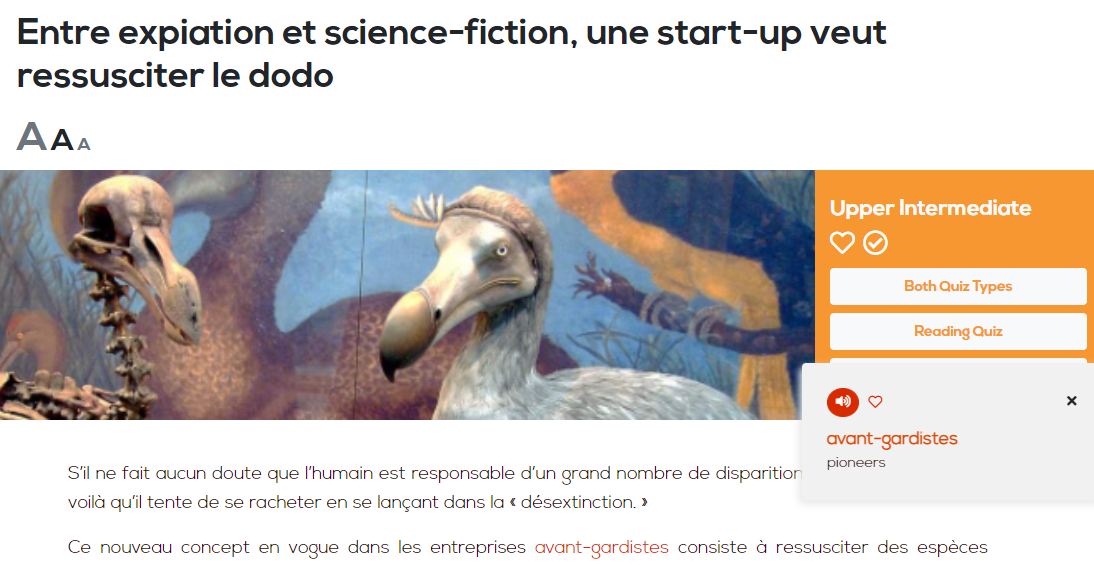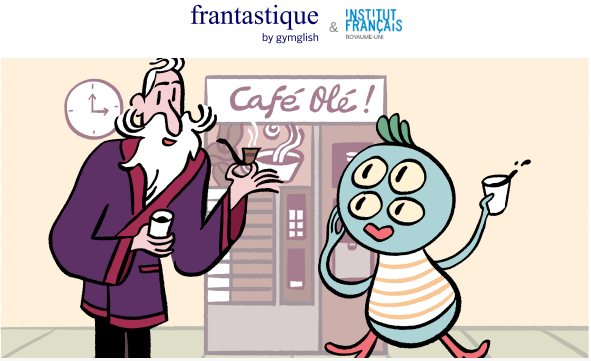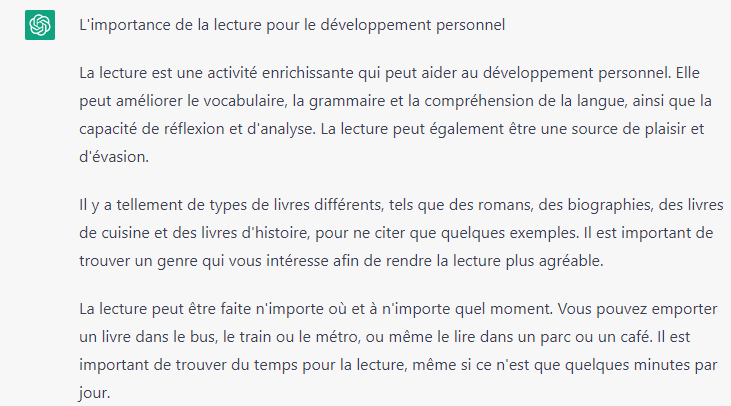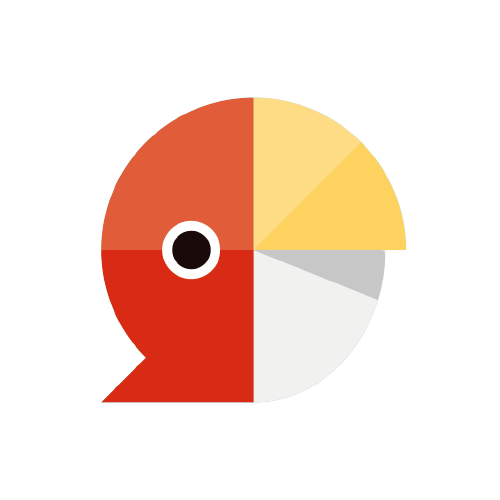13 French Reading Practice Tools for Busy Teachers
Reading French is a proven way to acquire new vocabulary, internalise grammar and sentence patterns, and improve comprehension skills. But those advantages are only realised when students actually make a habit of reading in French. Ideally, we want French reading practice to become a part of a language learner’s routine that is non-negotiable – and better yet, an activity that learners actually look forward to! Yes, it is possible. With that in mind, we’ve compiled a list of some of today’s top reading practice tools that are readily available for teachers and students to use.
What to look for in French reading practice tools
Here are some important factors to consider when selecting the most appropriate French reading practice tools for your students.
Accessibility
Being accessible means user-friendly, reasonably priced (if there is a cost), and at a suitable language level for the student: i.e. challenging enough to promote learning, but not so challenging that the student experiences frustration and discouragement. Some students may appreciate being able to read in French with an English translation, where this is available. Other students might prefer to have different tools at their disposal, such as an interactive dictionary.
Interest and engagement
As a teacher, naturally you want to provide students with material that sparks their interest and motivation to read in French. There are inherent barriers to reading in a second language, so the more engaging and informative the reading material is, the more the reader will be motivated to push through any initial resistance. One way to ensure that learners find reading material that is of interest to them, is to let them choose what they want to read. For example, you could let students pick from an entire library of texts (such as Newsdle), or offer them a choice of texts selected by you.
Authenticity
Reading practice in French should expose students to language that is representative of how native speakers communicate, as opposed to the contrived and often outmoded texts found in typical language course books. Authentic material may include idioms and colloquialisms, for example. Though many French learners are not equipped to handle a lot of authentic material, teachers could incorporate some authentic materials at their discretion, or provide adapted texts in a format that replicates authentic materials (e.g. reading French news articles on Newsdle, or French short stories on Beelinguapp).
It isn’t necessarily a matter of saving authentic materials for when students are ready, but rather giving them the support and tools to make authentic materials more accessible, whatever their language level. For more on this, check out the article: The Value of Using Authentic Materials in Foreign Language Teaching.
Why French reading practice online?
Online platforms have a number of advantages when it comes to reading in a foreign language, compared to their non-digital counterparts. Firstly, they are readily available: who doesn’t have a smartphone in their pocket these days? The portability of our devices means we can convert otherwise “wasted time” into learning opportunities, i.e. do some French reading or listening practice while waiting in line, during the daily commute, and so on. Technology makes it easier for French learners to benefit from immersive activities, even if you don’t live in a Francophone country.
Another significant advantage of using digital tools is that the reader can interact with the material in a way that will never be possible with print books. While reading a French book, if you don’t understand a key word (or multiple words), you are usually forced to divert your attention from the text in order to look up words in a dictionary. By the time you return to your reading, you may have forgotten what the context was. And if you want to keep a record of new vocabulary, you’ve got to be both proactive enough to write it down somewhere and organised enough not to lose it.
Using digital reading platforms, you only need to tap or click on a word to find out what it means, and in many cases you have the additional option of saving new words to your vocabulary bank or flashcard app for easy review later. How much faster it is to read – and expand your vocabulary – in this way, compared with traditional methods!
Recommended tools for French reading practice
With the above points in mind, here are 11 useful tools that are recommended to use with your students as part of their French reading journey.
Newsdle
Learn French using news? Mais oui ! When it comes to French reading practice, news is a particularly useful source of material, for several reasons. Firstly, new content is never going to run dry. Secondly, it deals with real people and events, which increases the relevance and relatability for the reader. In addition, news often connects with the reader’s pre-existing contextual knowledge or awareness, giving them a headstart in understanding the material (compared to, say, a fictional story or a random text from a course book). For these reasons, a news website like Newsdle may be the ideal source of accessible reading material for French learners.
The Newsdle website and app provide engaging news-based content tailored for learners at six different levels. Users benefit from current, continually-updated French articles to read that encompass a wide range of topics and interests. The site offers both individual subscriptions and classroom subscriptions; the latter option provides teachers with additional functionality, such as the ability to monitor student data and create homework assignments.

Newsdle includes a host of interactive features to help learners get the most out of reading in French: a one-click dictionary, flashcard tools, quizzes, and more.
Newsdle’s daily content includes audio recorded by native French speakers, as well as comprehension exercises and contextualised grammar lessons. A Newsdle subscription unlocks feature-rich resources that cater to learners of all levels, which makes the platform a compelling option for students who want to learn to read French online, and teachers who wish to save time with an all-in-one solution.
To learn more about saving time with Newsdle, check out the article: 10 Ways Language Teachers Can Save Time and Encourage Independent Learning W
Frantastique
Frantastique is akin to an interactive textbook for upper-beginner to pre-advanced-level French learners, which provides diverse and entertaining material for reading practice in French. Subscribers receive a personalised French lesson via email five days a week. Each lesson takes around 10-20 minutes to complete, either on the website or in the Frantastique app. The content is unique and whimsical, featuring characters such as Victor Hugo and his extraterrestrial friends.

Quirky and fun visuals are integral to Frantastique’s appeal.
Frantastique lessons are comprised of a story (in the form of comic strips, fictional news bulletins, audio, etc.) followed by comprehension and grammar activities. Users receive automated corrections including vocabulary and grammar explanations, and the system keeps track of users’ mistakes, prompting them to review content at optimal intervals.
ChatGPT
The launch of the advanced chatbot ChatGPT has caused excitement and concern in equal measure. Yes, it’s true that it may spell “the end of homework” – or at least require teachers to radically rethink how they assess students. But besides making it easier than ever to cheat on writing assignments, ChatGPT is also potentially an incredible resource for language learners and teachers.
Give the chatbot a prompt, such as “Write a text in French for an intermediate learner”, and you will get something appropriate in response (my prompt elicited several paragraphs about the benefits of reading for personal development). The bot can engage in a human-like dialogue and will refine its responses based on your further interaction with it. ChatGPT, and AI in general, still have a long way to go: it is not always a reliable source of information, nor is it up-to-date with current affairs (at the time of writing), but for both teachers and students it is certainly worth taking time to experiment and see what you can do with it.

ChatGPT can provide reading material in French in response to the user’s request.
Le Monde Mémorable
From the same team behind Frantastique, Le Monde Mémorable is aimed at French speakers who want to expand their general knowledge via daily bite-size lessons, with a focus on history, society and culture. Every lesson includes the opportunity to review previously learned material, followed by a new topic and comprehension questions. Designed with native speakers in mind, Mémorable would be most appropriate for advanced students of French with an appetite for sophisticated language and niche subject matter. Again it’s a paid subscription, offering the additional benefit of access to French articles to read via Le Monde website.
Français Authentique
For reading practice in French, Français Authentique has plenty to offer. This popular YouTube channel has expanded into an app, podcast and blog, featuring written content in addition to audio and video. Frequent topics include idiomatic French expressions, explanations of grammar, and creator Johan’s insights into personal development and self-improvement. Users can find a wealth of free content for French reading practice, which is digestible enough for intermediate learners, while also offering advanced students an opportunity to enrich their vocabulary and self-expression with everyday idiomatic French.
LingQ
Founded by Canadian polyglot duo Mark and Steve Kaufmann, LingQ is a content- and feature-rich platform and app for learning a wide range of languages, French included. It offers a wealth of content tailored for different levels, including French short stories designed to instill grammar and sentence patterns. Additionally, there is an import feature which can turn the user’s chosen content into an interactive lesson. There is also an inbuilt Spaced Repetition System for drilling vocabulary. To access the full set of features, a paid subscription is required.
Beelinguapp
For those looking to learn to read French online, this app provides free and premium content for different levels. Users are able to select their level, choose their topics of interest, and read French texts with an English translation side-by-side. Native speaker audio is available along with a “karaoke feature” so that the reader can follow the text easily. Paying for a premium account removes ads and unlocks additional features and stories. Beelinguapp is a valuable source of French reading for beginners, as well as intermediate and advanced learners.
1jour1actu
This site provides news - actus - aimed at kids, but in a way that is visually appealing and not at all condescending. As well as weekly news summaries and current affairs in accessible French, there are also animated videos, interactive quizzes, and guided resources to encourage the development of critical thinking skills. The clear presentation and kid-friendly design of the website make it easy to navigate. The content is especially suitable for intermediate learners regardless of age.
Wikipédia
The infamous “free encyclopaedia” website or app serves as a vast source of authentic French reading material on any topic. Instead of habitually searching for information in one’s native language, why not combine two learning opportunities into one, and practise reading in French while researching topics of interest? As a multilingual platform, any Wikipedia page in French can be easily cross-referenced with the corresponding English page.
E-books
When it comes to reading in French, print books and e-books are both valid options, but reading e-books on an e-reader or tablet has clear advantages, just like apps: tap on any word on the page and retrieve an instant definition or translation, allowing for a far smoother and more seamless reading experience than using an external dictionary to look up words. Entry-level books for easy French reading could include graded readers or parallel texts, the timeless classic Le Petit Prince by Saint-Exupéry, or Sempé and Goscinny’s children’s book series, Le Petit Nicolas. For more advanced readers, the works of Albert Camus, Jules Verne and Voltaire are considered accessible and culturally significant.
Lingua.com
For those who want to learn to read French, Lingua’s content is worth a look. For beginner to lower-intermediate learners, plenty of free reading material is offered, including short texts and dialogues complete with comprehension quizzes. The content is of everyday relevance, focusing on daily life, French culture, family, and travel. Advanced French readers may find Lingua’s texts to be lacking in variety and depth, and the majority of B2 texts are premium-only, but there is a substantial amount of easy French reading material for beginners and intermediate learners.
RFI Savoirs
RFI Savoirs claims to provide “the keys to understanding the world in French”, and with its Journal en français facile, it aims to do just that. Monday to Friday, an audio summary of the latest world news is provided, with accompanying transcripts for those looking for French reading practice. The language is clear and accessible, as it should be for a site branded “easy French”. Additional features and personalised learning are limited, but the free, up-to-date content is suitable for autonomous learners who want to read in French while listening to native speaker audio.
Google News
Google News, or Google Actualités, is a daily source of French articles to read that can be customised to the user’s preferences, such as filtering by region or topic. For advanced French learners who ordinarily read the news in their native language, switching their daily news consumption to reading in French makes sense. As with any Google search, the quality and accuracy of content is not guaranteed, and nor is there any specific tailoring towards French learners of different levels; therefore Google News, and francophone news sites in general, are less optimal for French reading practice than learner-friendly platforms like Newsdle or Beelinguapp.
Additional tips for reading French
Maximise immersion
As much as possible, encourage students to get accustomed to thinking and learning exclusively in French, instead of habitually translating unknown words into their native language. For example, upper-intermediate to advanced learners could be encouraged to look up words in a monolingual French dictionary instead of immediately reaching for a translation (even if the latter is faster). When doing in-class reading activities, use French when giving instructions, and encourage students to discuss the reading in French too.
Visuals matter
The old cliche is that a picture speaks a thousand words. Well, when reading in a foreign language, the power of visuals is not to be underestimated. A picture or two can capture the reader’s interest and give context clues that will aid understanding. Other details matter, too. Fonts that are unattractive or hard to read can be significantly off-putting. Attractive colours and design may help to engage readers who are easily distracted or demotivated.
Utilise the combined power of reading and listening
If students have access to an audio version of the text recorded by a native speaker, they can benefit from hearing the natural cadence and intonation of spoken French, which may also facilitate their comprehension of the material while training their ear to native pronunciation.

Newsdle articles allow for simultaneous French reading and listening practice.
Include comprehension activities
Extension activities such as quizzes can test the student’s comprehension of a text, without feeling like too much extra effort on the student’s part. If built-in comprehension exercises are not readily available, then writing a summary – ideally in French – is an effective way to test one’s own understanding of the material.
Increase passive exposure to French
We all use devices daily anyway, so we may as well turn them to our advantage for learning to read in French. Switching the default language of a smartphone or laptop is an easy and painless way to increase one’s passive exposure to the target language. With a simple change, one’s inbox is transformed into a boîte de réception; instead of browser tabs, we’re now using onglets.
Support active vocabulary building
While passive exposure to the target language has merits, active learning empowers the learner and ensures that new material sticks around in the long-term memory. During each French reading practice session, identify up to 10 new words or phrases encountered in the text. An old-school method of vocabulary building would be to write down each word or phrase along with a definition and/or translation, and an example of the word or phrase used in a sentence. A more modern, tech-savvy approach would be to add the word or phrase to one’s preferred flashcard or SRS app so that the new vocabulary can be reviewed at regular intervals.
Embrace challenge and uncertainty
Let’s face it, reading in French is a skill that takes time to develop; at first it may feel arduous, even disheartening, but persistence ultimately pays off. Readers should manage their expectations, look for context clues around unfamiliar vocabulary, and get comfortable with a degree of ambiguity. If the reading material is appropriate for the learner’s level, then there will be plenty of familiar words and some that are new, but the overall intelligibility of the text should be high.
In summary
This article presented a range of online tools that students of French can use to gain exposure to the written language and, given sufficient time and dedication, learn to read French with greater ease and enjoyment. Some of the tools cater to learners of all levels, whereas others are more suited to beginners, intermediate or advanced students. Different tools may also prove more or less useful depending on the individual learner’s level of motivation and autonomy. Whichever tools or strategies a student opts for, they should strive to make reading French a regular habit, and relish the feeling of accomplishment that comes from making progress in a foreign language.
Author:

Daisy Ward is an experienced online English teacher, writer and content creator with a passion for foreign languages and cultures. Her expertise in effective language-learning strategies is derived from many years in language classrooms, both as a teacher and as a student. Fluent in French and competent in Mandarin Chinese, she attributes much of her success in learning languages to the use of apps and other online tools.


